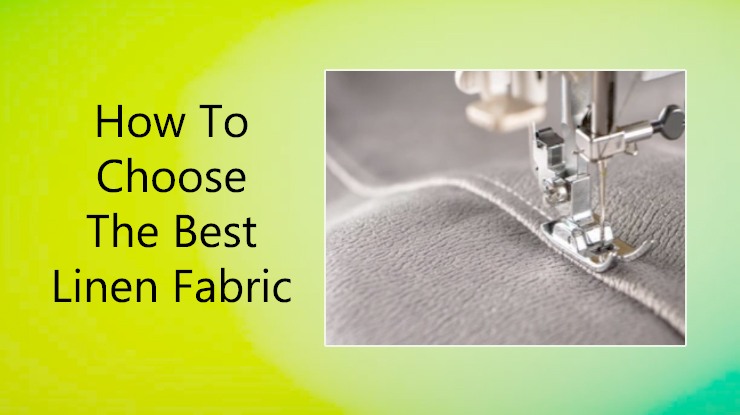Is your couch always unclean because of your pets and children?
Are you tired of cleaning your couch constantly every day? I can understand the feeling.
When you have guests over for a game, all you do is pray that your children don’t throw food crumbs and your dog doesn’t stain your couch.
It is not easy to maintain a polyester couch as it takes a lot of effort.
Don’t worry. In this guide, I will explain in detail the simple and modern methods on how to clean your couch.
Get ready for remedies you have not read before. Based on my extensive research and a few tips from my grandma. I have concluded the following article.
Before we get into details here is a short version with bullet points if you don’t feel like reading the entire article.
- Cloth & Brush: Mild soap and vinegar solution, light misting, gentle dabbing & scrubbing, rinse & repeat, air dry. This always works.
- Upholstery Cleaner: Check the cleaning code, test before use, vacuum first, choose water or solvent-based cleaner, clean & extract, and air dry quickly.
- Steam Cleaner: Use a handheld attachment with squeegee & shield, initial steam pass, focused cleaning for stains, diluted detergent for stubborn dirt, repeated cleaning & pad maintenance, and complete drying. This creates the perfect recipe for steam cleaning.
- Homemade: Use baking soda & soap solution, a damp microfiber towel, and a pot lid handle, scrub the couch with a pot lid, repeat & re-wet as needed.
Now let’s get into more details.
Preparing For Polyester Couch Clean-Up
First thing is first! Before you start cleaning your polyester couch, it’s important to prepare adequately to ensure the process is smooth, effective, and most importantly safe!
If you want the best results, start by gathering all the necessary materials.
Here is what else you need: mild dish soap, warm water, white vinegar (for tougher stains), a clean spray bottle, soft clothes, a soft-bristle brush, and a dry towel.
These tools are essential whether you’re doing a simple spot cleaning or a more thorough cleanse.
Additionally, if you’re using a steam cleaner or an upholstery cleaner, make sure you have the right attachments and solutions ready.
For the cleaning process itself, the first step is always to check the fabric’s cleaning code. This code, found on the furniture tag, guides you on the safest cleaning method for your couch.
If your couch doesn’t have a tag, a quick online search for the manufacturer’s guidelines or a call to the retailer can provide the needed information.
Before you start as the experts indicate, test your cleaning solution on a small area of the couch.
This is just to ensure it doesn’t cause any discoloration or damage.
Once everything is in place, you’re ready to proceed with the cleaning method that best suits your couch’s needs, be it a gentle hand cleaning, a thorough vacuuming, a deep steam clean, or a creative DIY method using homemade equipment.
Method 1: Cleaning with a Cloth and Brush
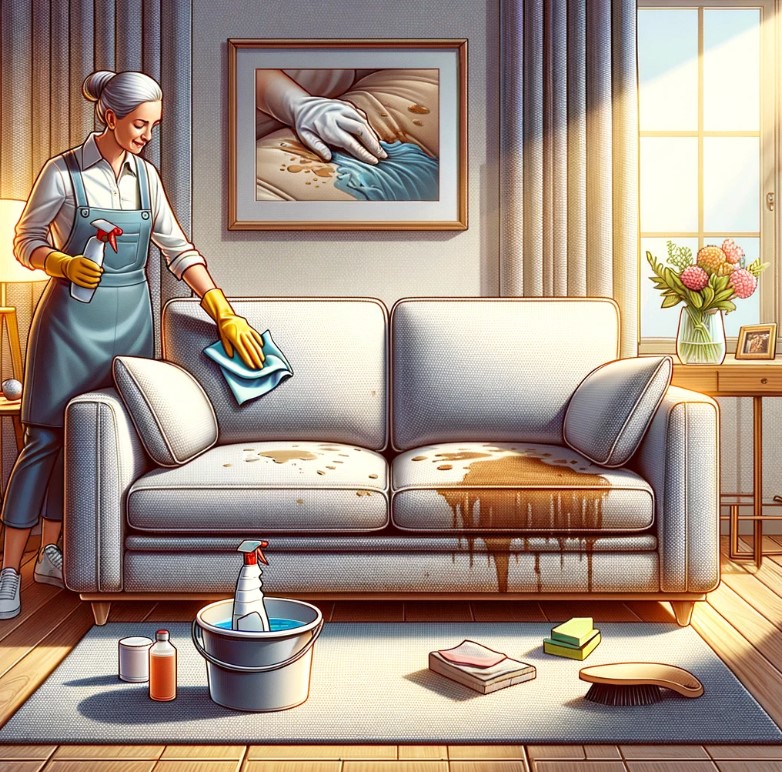
Let’s begin! I’m going to show you a super easy way to clean it using just a cloth and brush.
It’s quick, and simple, and will make your couch look awesome again.
Prepare the Cleaning Solution
- Let’s get started, mix a solution of mild dish soap and water. The ratio should be about one teaspoon of dish soap to one cup of warm water.
- For tougher stains, you can add a small amount of white vinegar to the mixture, which helps in breaking down more stubborn stains without damaging the polyester fabric.
Initial Application
- Using a clean spray bottle, lightly mist the stained area with your cleaning solution. It’s important to avoid soaking the fabric, as excessive moisture can lead to water stains or damage to the polyester fibers.
- For larger stains, cover the entire area evenly with the mist. This will give you a deep clean.
Choosing Your Cleaning Tools
- Soft Cloth: It is ideal for blotting and gentle wiping.
- Soft-Bristle Brush: This brush is useful for lightly scrubbing the fabric to loosen the stain.
- No particular company is required; you can get any of the brands according to your preference.
Here comes the Scrubbing
- Begin by gently dabbing the stained area with a soft cloth to absorb the cleaning solution and lift the stain.
- If the stain persists, use the soft-bristle brush in a circular motion, applying minimal pressure to avoid damaging the fabric.
Rinse and Repeat
- After scrubbing, dampen a clean cloth with plain water and blot the area to remove any soap residue.
- You need to repeat this step until no soap is left on the couch.
Drying the Couch
- Try using a dry towel to blot the cleaned area, absorbing as much moisture as possible.
- Allow the couch to air dry completely. Avoid using heaters or blow dryers as they can damage the polyester fabric. What I would recommend is putting it in the open.
Repeat if Necessary
- If the stain is still visible after the first attempt, repeat the process. Sometimes, particularly stubborn stains may require a second or third treatment.
Final Inspection
- Once the couch is dry, inspect the area to ensure the stain is completely removed.
- If a faint stain or odor persists, consider repeating the cleaning process or using a fabric freshener.
Additional Tips
- Test the cleaning solution on a small, hidden area of the couch to ensure it doesn’t cause discoloration.
- Always use lukewarm water as hot water can set certain types of stains.
- If the couch has removable covers, check the care labels for washing machine instructions.
- For persistent or complex stains, consider consulting a professional upholstery cleaner.
Method 2: Using an Upholstery Cleaner
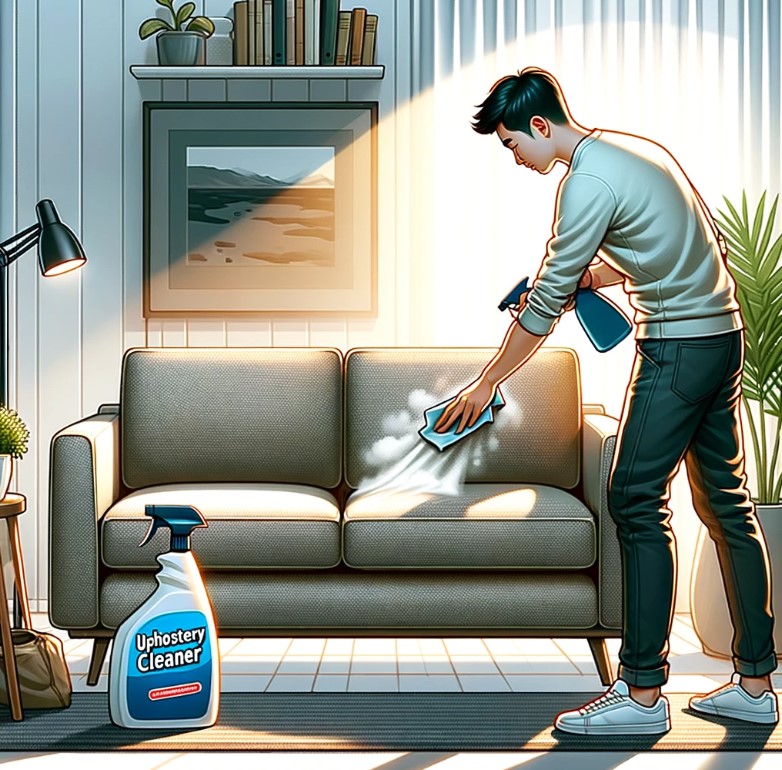
Cleaning a polyester couch might seem daunting, but with the right upholstery cleaner and techniques, it’s a breeze.
Here’s a step-by-step guide to help you get your couch looking spotless and fresh.
Check the Cleaning Code
Firstly, you need to locate the cleaning code on your furniture’s tag. This code indicates the suitable cleaning method:
W: Water-based cleaning solutions are safe.
S: Requires dry cleaning with a solvent.
SW: Both water-based and solvent-based cleaners are acceptable.
X: Professional cleaning is recommended; avoid DIY methods.
If your furniture lacks a tag, you can search online for the manufacturer’s cleaning guidelines or contact the retailer for advice.
Test in a Low-key Area
- Before cleaning the entire piece, test your chosen cleaner on a hidden area, like the underside of a cushion.
- This helps ensure the cleaner doesn’t cause discoloration, watermarks, or shrinkage.
- Thoroughly Vacuum First:
- You also need to vacuum the furniture to remove dust and dirt.
- This step is crucial for preventing dirt from mixing with your cleaning solution, which can lead to less effective cleaning.
Choose the Right Cleaner
- For water-based cleaning: Mix one cup of rubbing alcohol, one cup of water, and a few drops of Dawn dish soap. This DIY solution is gentle yet effective. Call it my Grandmother’s way.
- For solvent-based cleaning: Consider a recommended product (you can find suggestions online), ensuring it’s suitable for your specific upholstery.
Clean and Extract
- Start by spraying the cleaner on the upholstery and scrubbing it using a soft bristle brush or a towel.
- If you have a carpet cleaner with an upholstery attachment, use it with water only to thoroughly flush the area. This process helps remove both the cleaner residue and embedded dirt.
- Without an extractor, use a spray bottle filled with warm water to mist the area and wipe it with a dry microfiber towel.
- This method is less effective than full extraction but still improves cleanliness.
Dry Quickly
- Lastly, accelerate drying by increasing airflow. Open windows, use fans, or even a small snail fan to promote quick drying.
- If you’ve cleaned cushions or pillows, stack them to allow air to circulate around each surface, speeding up the drying process.
Method 3: Using a Steam Cleaner Setup
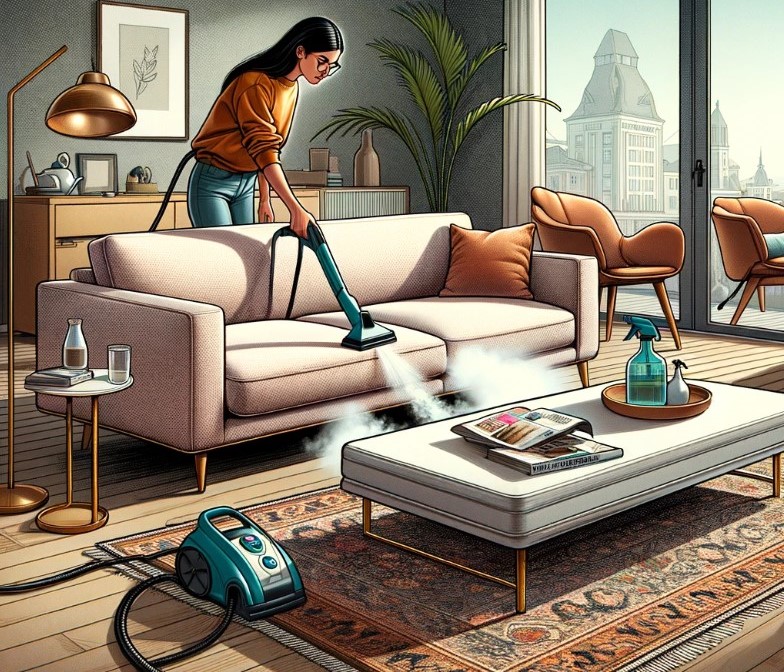
Steam cleaning a polyester couch is a fantastic way to achieve a deep clean without resorting to harsh chemicals.
Let’s explore the steps and benefits of using a steam cleaner for your couch.
Steam Cleaner Setup
- Use a steam cleaner that has a handheld attachment. Most steam cleaners designed for floors also have this feature.
- Equip the steam cleaner with a squeegee tool, which is typically used for upholstery, and cover it with a carpet attachment shield.
- This setup is crucial for protecting the fabric while effectively cleaning it.
Initial Steam Cleaning
- You can start by giving the couch a thorough once-over with just the steam. This step doesn’t require any detergent, only water.
- The steam helps lift dirt and grime, and since it doesn’t use detergent, it reduces the risk of leaving wet patches or residue.
Dealing with Stuck Dirt and Stains
- For areas with significant dirt or specific stains (like vomit, pet’s mess, wine stain, ketchup, etc.), focus more intensely on the steam cleaner. The steam helps to loosen and lift these tougher spots.
- Be cautious as the attachment and cloth can get very hot, posing a risk of steam burns.
Using a Detergent
- If the steam alone isn’t enough, you can sprinkle a diluted solution of a mild detergent over the couch. This can help break down more stubborn dirt.
- It’s crucial to use the detergent sparingly and to ensure it’s suitable for the couch’s fabric.
Repeated Cleaning and Pad Maintenance
- You need to clean the couch several times, especially for deeply ingrained dirt. Between cleanings, rinse the pad attached to the squeegee tool.
- The pad should be white or light-colored to help you see the dirt it’s removing. Hand wash the pad as needed, especially when it becomes visibly dirty.
Post-Cleaning Care
- After steam cleaning, allow the couch to dry completely. This might involve leaving it for a while or using fans to speed up the drying process.
- Check the couch once it’s dry to ensure all dirt has been removed. If necessary, repeat the cleaning process.
Pre-Cleaning Preparation
- Before using the steam cleaner, vacuum the couch thoroughly. This removes loose dirt and debris and makes the steam cleaning more effective.
Method 4: DIY Cleaning with Homemade Equipment

With some simple, homemade solutions, you can easily maintain and refresh your couch, keeping it spotless and inviting.
Let’s explore some DIY cleaning tips using everyday items.
Prepare the Cleaning Solution
- In a container, mix half a liter of warm water with one tablespoon of baking soda and one tablespoon of dishwashing soap. This mixture is gentle yet effective for cleaning fabric surfaces.
Use a Microfiber Towel
- Soak a microfiber towel in the cleaning solution. Microfiber is excellent for this purpose because it helps remove dirt easily. Ensure the towel is damp but not overly wet to avoid soaking the fabric of your couch or rug.
The Pot Lid Technique
- Take a common pot lid and wrap the damp microfiber towel around it. This creates a convenient and effective tool for cleaning.
Cleaning Process
- Use the towel-wrapped pot lid to scrub your couch, focusing on areas with more dirt or stains.
- Apply more pressure on heavily soiled areas. The stains and dirt should lift off, making your couch look refreshed and new.
- This method is also effective for removing lint stuck on the fabric.
Repeat for Other Areas
You can use the same technique to clean carpets and even beds, especially if they have stubborn stains.
Reapply and Continue
If the towel becomes dry or too dirty, re-wet it with the cleaning solution and continue the cleaning process.
5 Great Tips to Keep Your Couch Clean
Here are a few handy tips and tricks that have helped me keep my couch clean.
Managing a busy household with five people, a Husky, and a Persian cat means our furniture has to endure a lot.
These simple yet effective strategies will help you keep your couch looking fresh and clean, so no more worrying about dirt and food crumbs.
Let’s dive right into these details.
Odor Control and Food Management
Regular airing: Open windows to allow fresh air circulation, reducing musty smells and maintaining fabric freshness.
Fabric fresheners: Use fabric-safe fresheners specifically designed for upholstery. They help in maintaining a pleasant scent without damaging the material.
Immediate cleanup: Promptly remove food chunks with a soft brush or a damp cloth to prevent them from sticking to the fabric.
Child-Proofing and Couch Protection
Use washable slipcovers: They provide an extra layer of protection against spills and can be easily removed for cleaning.
Corner protectors: Install soft corner protectors to safeguard children from sharp edges.
Accent pillows: Use them not just for comfort but also to shield the couch from direct contact with skin, hair, and clothing.
How to Maintain Your Polyester Couch?
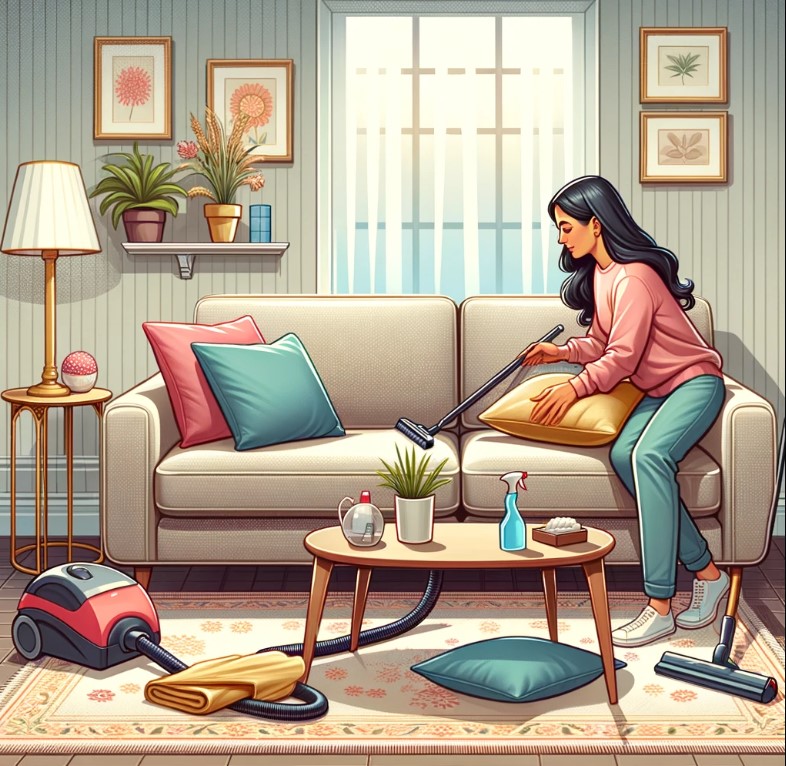
Maintaining your polyester couch is not just about keeping it clean; it’s about smart prevention and effective solutions.
Let’s dive into some easy yet effective ways to keep your couch looking as good as new.
Prevention is Your Best Defense
In order to have the best defense, vacuuming regularly is crucial as dust, dirt, and allergens can lead to stains.
A weekly vacuuming session, more frequently if you have pets, will keep the fabric free from these elements.
Being prepared for spills is also key.
It’s important to blot up excess liquid immediately with a clean, absorbent cloth, remembering that blotting is better than rubbing, which can spread the stain.
For tougher stains, use a mild cleaning solution, but always test it on an inconspicuous area first.
Protect your couch from the sun as direct sunlight can fade the vibrant colors.
Position it away from windows or use curtains/blinds to minimize exposure to UV rays.
Lastly, try to designate specific zones for eating and drinking to avoid accidental stains on your furniture.
Swift and Effective Stain Removal
Knowing the type of stain you’re dealing with is essential, as different stains require different cleaning methods.
For example, grease stains need a different approach than wine stains.
Always test any cleaning solution on a hidden area of the couch to ensure it won’t cause damage.
When tackling a stain, gently blot it with a clean, absorbent cloth instead of rubbing, which can worsen the situation.
Be persistent and repeat the blotting and cleaning process until the stain is completely removed.
Tips for a Stain-Free Life
Applying a fabric protector can be a game-changer. This invisible barrier helps repel stains and makes cleaning easier.
Using throws or blankets can protect your couch from spills and everyday wear and tear, adding an extra layer of defense.
Every few years, consider giving your couch a professional cleaning.
This helps remove deep-seated dirt and stubborn stains, rejuvenating your couch and extending its lifespan.
Conclusion
In the end, I have provided a walkthrough for keeping your polyester couch in condition, from simple spot treatments to deep cleaning, it covers a variety of methods tailored to different needs and stain types.
Just in case, A quick recap:
Method 1: Cleaning with a Cloth and Brush involves a mixture of dish soap and water, or vinegar for tougher stains, followed by gentle scrubbing and blotting.
Method 2: Using an Upholstery Cleaner requires checking the cleaning code of your furniture and using either water-based or solvent-based cleaners, depending on the fabric.
Method 3: Using a Steam Cleaner Setup is about using steam power to lift dirt and grime, with an option to use a mild detergent for more stubborn stains.
Method 4: DIY Cleaning with Homemade Equipment: It is a unique approach using a mix of baking soda and dish soap for a gentle yet effective clean, employing a microfiber towel and a pot lid for innovative cleaning.
Tips and Tricks: Implement washable slipcovers, corner protectors, and accent pillows to safeguard the couch against spills, wear, and tear, while also enhancing its style.
How to Maintain: Regularly air your couch, don’t forget to use fabric-safe fresheners, and prompt removal of food particles to keep the couch fresh, odor-free, and tidy.
This article is your go-to resource for tackling any challenge that life, kids, or pets might throw at your beloved couch.
For a more detailed guide on how to clean upholstery and other materials see our other articles.


